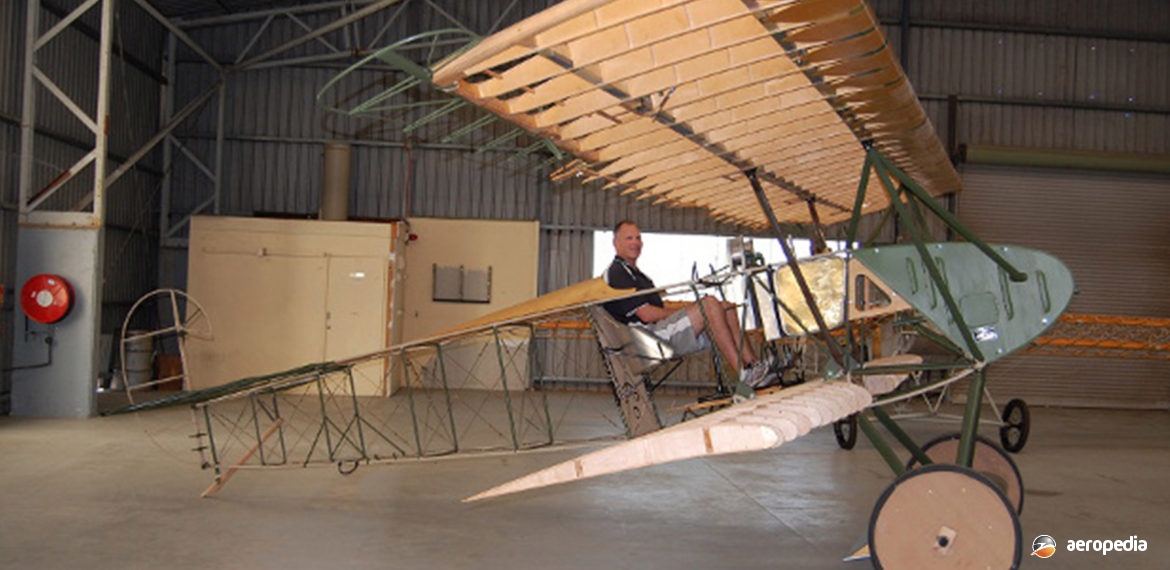Photograph:
Fokker D.IV replica during construction at Caboolture, QLD (TAVAS))
Country of origin:
Germany
Description:
Single-seat fighting scout
Power Plant:
One 119 kw (160 hp) Mercedes D.III six-cylinder in-line liquid-cooled engine
Specifications:
- Wingspan: 9.7 m (31 ft 10 in)
- Length: 6.3 m (120 ft 8 in)
- Height: 2.45 m (8 ft 0½ in)
- Wing area: 21 m² (227 sq ft)
- Max speed: 160 km/h (100 mph)
- Rate of climb: 336 m/min (1,102 ft/min)
- Climb to 1,000 m (3,280 ft): 3 mins
- Endurance: 1½ hrs
- Operational ceiling: 4,000 m (13,123 ft)
- Range: 220 km (354 miles)
- Empty weight: 606 kg (1,333 lb)
- Loaded weight: 841 kg (1,850 lb)
Armament:
One 7.92 mm (0.303 in) fixed Spandau LMG08/15 machine gun
History:
The Fokker D.I and D.IV were developments by Fokker of the M.18 prototype, the D.I being the production variant of the M.18z, the ‘z’ indicating Zweistielig, meaning a two strut or two bay biplane. It was fitted with a 90 kw (120 hp) Mercedes II engine. However, this aircraft was not successful, not being able to compete in manoeuvrability and climb with opposing aircraft. Fokker then looked to develop the design which was modified to take the 119 kw (160 hp) Mercedes D.III engine, becoming known as the D.IV.
Construction was orthodox, the fuselage being a welded steel tube braced in all planes with stranded cables to form a rigid-braced box girder structure and was fabric covered aft of the cockpit. The wings were straight parallel-chord of equal span with a slight angular rake at the tips. Interplane struts were of circular steel tube faired off with wood fairings. The undercarriage was conventional Vee-type chassis of steel tube with wood fairings and sprung with elastic shock cord.
The D.IV had an improved performance over the D.I but still was not able to compete with aircraft such as the Albatros D series, which at that time was entering service and in the event the D.I and D.IV, which were only produced in small numbers, were relegated to non-operational duties with flying schools. Total production of the D.I was 25 aircraft, and 33 examples of the D.IV were completed at the Fokker facility known as Fokker Flugzeug-Werke GmbH.
Jasta 2 did have Fokker D.Is on its roster and one, flown by Lieutenant Grafe from that unit, was shot down by Captain Albert Ball VC on 21 September 1916 east of Bapaume in France.
A few replicas of the Fokkern D.IV have been constructed, and in 2002 one of these, constructed in the United States by Carl Swanson, arrived at Omaka airfield, Blenheim, New Zealand, being restored and placed on the Civil Aircraft Register as ZK-JPV² (c/n 266-3) to the Omaka Collection on 21 December 2005. This aircraft was built for the movie ‘The Blue Max’ and was part of the Ryder Collection at Guntersville in Alabama in 1999.
The aircraft was obtained by Sir Peter Jackson and shipped to New Zealand to become part of his collection of World War I aircraft, painted in the colours of Lt Johann Janzen of Jasta 6, fitted with a 112 kw (150 hp) Tigre in-line engine. Mr Swanson was prolific in his production of replica aircraft, producing as many as 37 replicas and restorations at his facility at Darien in Wisconsin. The aircraft is not known to have been placed on display at an event at Hood Aerodrome, Masterton. However it was test flown there at one stage and was found not to be a good flyer. It was then placed in storage, probably at Trentham.
A further replica became ZK-SSW (c/n S.10) and was built in the United States by Carl Swanson. In late 2019 its ownership was transferred to the New Zealand Warbirds Association at Papakara.
Another replica has been contructed by TAVAS at Caboolture, QLD joining a collection of replica World War I aircraft.

